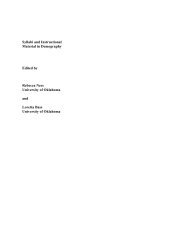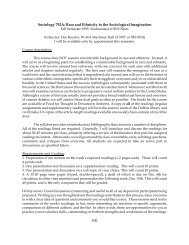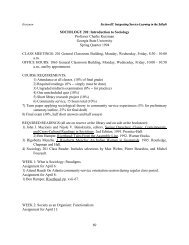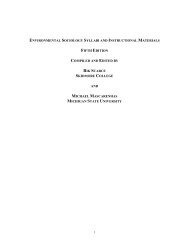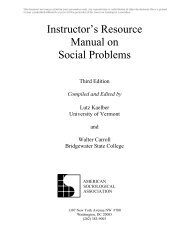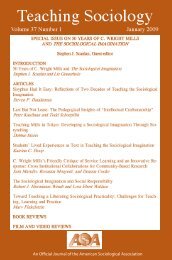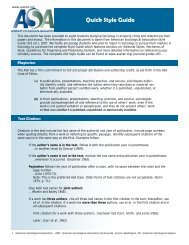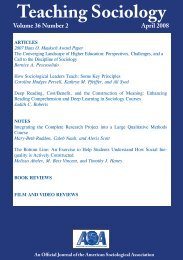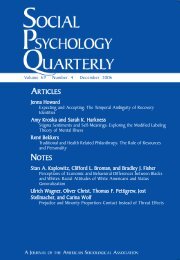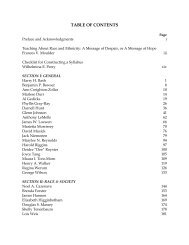SOCIOLOGY EDUCATION - American Sociological Association
SOCIOLOGY EDUCATION - American Sociological Association
SOCIOLOGY EDUCATION - American Sociological Association
You also want an ePaper? Increase the reach of your titles
YUMPU automatically turns print PDFs into web optimized ePapers that Google loves.
Gender, Obesity, and Education 251<br />
that were created by the school-based sampling<br />
frame (Chantala and Tabor 1999).<br />
Because all the outcomes that were examined<br />
in this study were either binary, count, or<br />
countlike ordinal variables, the glimmix<br />
macro was used to convert the mixed procedure<br />
to logistic and Poisson regression. All the<br />
models contained a random intercept for the<br />
outcome and a random slope for obesity, and<br />
all the variance components were statistically<br />
significant (p < .001).<br />
RESULTS<br />
A Profile of Obese Adolescents and<br />
Their Peers<br />
Adolescents whose BMI reached the threshold<br />
for obesity at Wave I differed from their<br />
nonobese peers in multiple ways, both during<br />
and after their secondary school careers. Most<br />
important, only 23 percent enrolled in college<br />
after high school, compared to 35 percent<br />
of their nonobese peers. They were also<br />
more likely to be boys (57 percent versus 46<br />
percent of nonobese youths) and racial/ethnic<br />
minorities (45 percent were African<br />
<strong>American</strong> or Latino/Latina versus 36 percent<br />
of nonobese youths). Moreover, the average<br />
level of parental education was in the range<br />
of a high school diploma (2.79) for the obese<br />
youths but in the range of some college<br />
(3.00) for the nonobese youths. Finally, the<br />
obese adolescents had significantly higher<br />
mean levels of self-rejection, class failures, and<br />
truancy than did their nonobese peers, but<br />
they did not differ significantly from these<br />
peers in terms of suicidal ideation or substance<br />
use.<br />
Obesity and College Enrollment<br />
The descriptive statistics just presented provide<br />
preliminary evidence that young people<br />
who were obese during middle school and<br />
high school had lower rates of college matriculation<br />
in the period after high school than<br />
did their peers. Moreover, they suggest that<br />
the fewer socioeconomic resources and<br />
greater psychosocial risks of obese youths<br />
may be reasons for these lower rates. Table 2<br />
presents the results of logistic regressions that<br />
more accurately estimate the longitudinal<br />
association between adolescents’ obesity and<br />
college enrollment, net of numerous demographic,<br />
school, adolescent, and social characteristics<br />
that are associated with both obesity<br />
and educational attainment.<br />
For the boys, obesity at Wave I was not significantly<br />
associated with being enrolled in, or<br />
having graduated from, college at Wave III<br />
once the four sets of selection factors (demographic,<br />
school, adolescent, social) were<br />
taken into account. Additional analyses not<br />
shown in Table 2 revealed no significant interaction<br />
between boys’ obesity and the proportion<br />
of obese boys (or girls) in the school. For<br />
the girls, however, obesity at Wave I was associated<br />
with significantly lower odds of attending<br />
college at Wave III. Obese girls had 50<br />
percent lower odds (1 – OR x 100) of being in<br />
(or having graduated from) college during<br />
this period than did nonobese girls, net of all<br />
four sets of Wave I selection factors.<br />
Again, two interaction terms were added<br />
to this base model: obesity x the proportion<br />
of obese boys in the school and obesity x the<br />
proportion of obese girls in the school. The<br />
former was not statistically significant, but the<br />
latter was (p < .001). Because odds ratios are<br />
not appropriate for interaction terms, I used<br />
the significant logistic coefficients of obesity,<br />
proportion of obese girls in the school, and<br />
the interaction between the two to calculate<br />
the predicted odds of college enrollment for<br />
different groups of girls. Specifically, I calculated<br />
the odds of Wave III college enrollment<br />
for obese and nonobese girls who went to<br />
schools with no other obese girls and who<br />
went to schools in which 10 percent of the<br />
student body was made up of obese girls<br />
(one standard deviation above the mean on<br />
this school variable). In doing so, I held all<br />
other variables in the model to their sample<br />
means.<br />
Nonobese girls generally had better odds<br />
(about 18 percent higher) of attending college<br />
when they attended schools in which no<br />
obese girls could be found in the student<br />
body than when they attended schools in<br />
which obese girls made up a relatively large<br />
proportion of the student body. Conversely,<br />
obese girls generally had better odds (about



